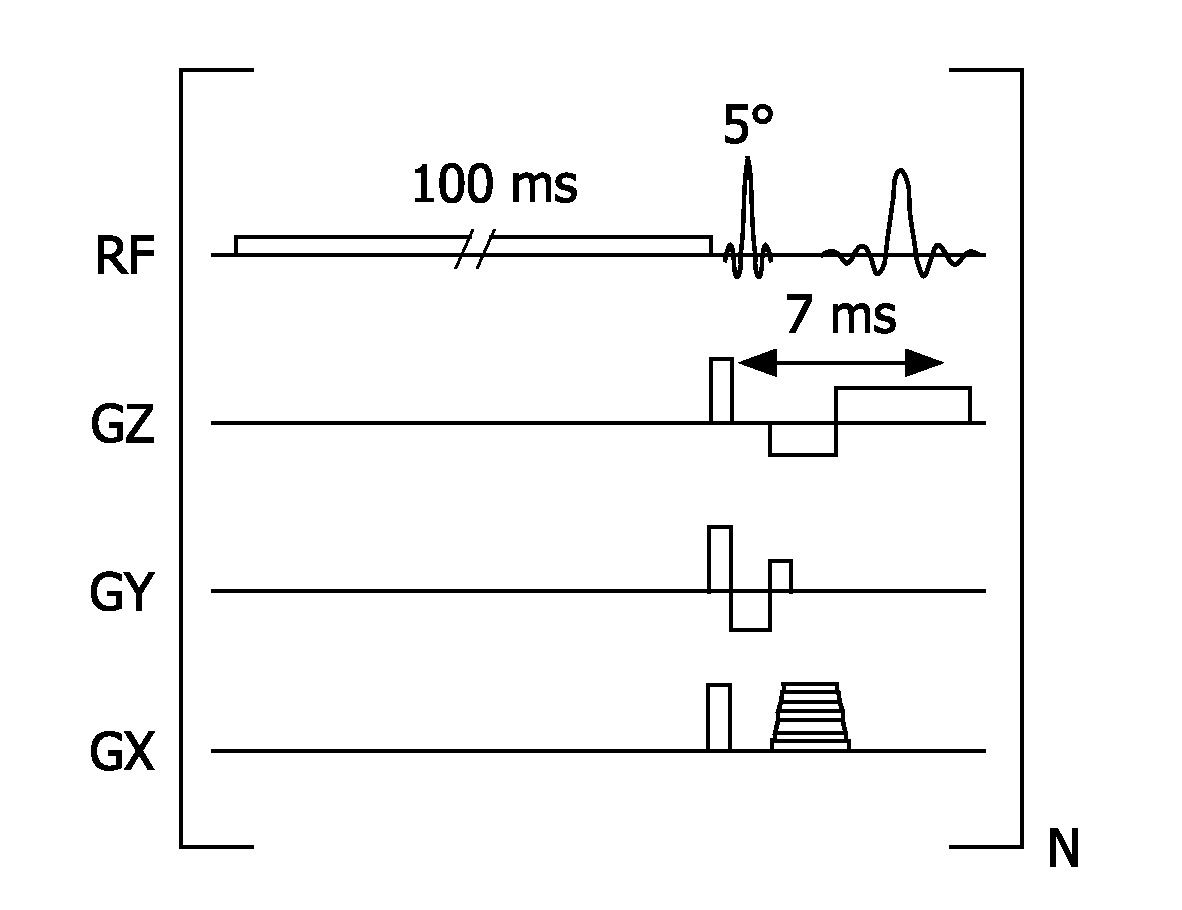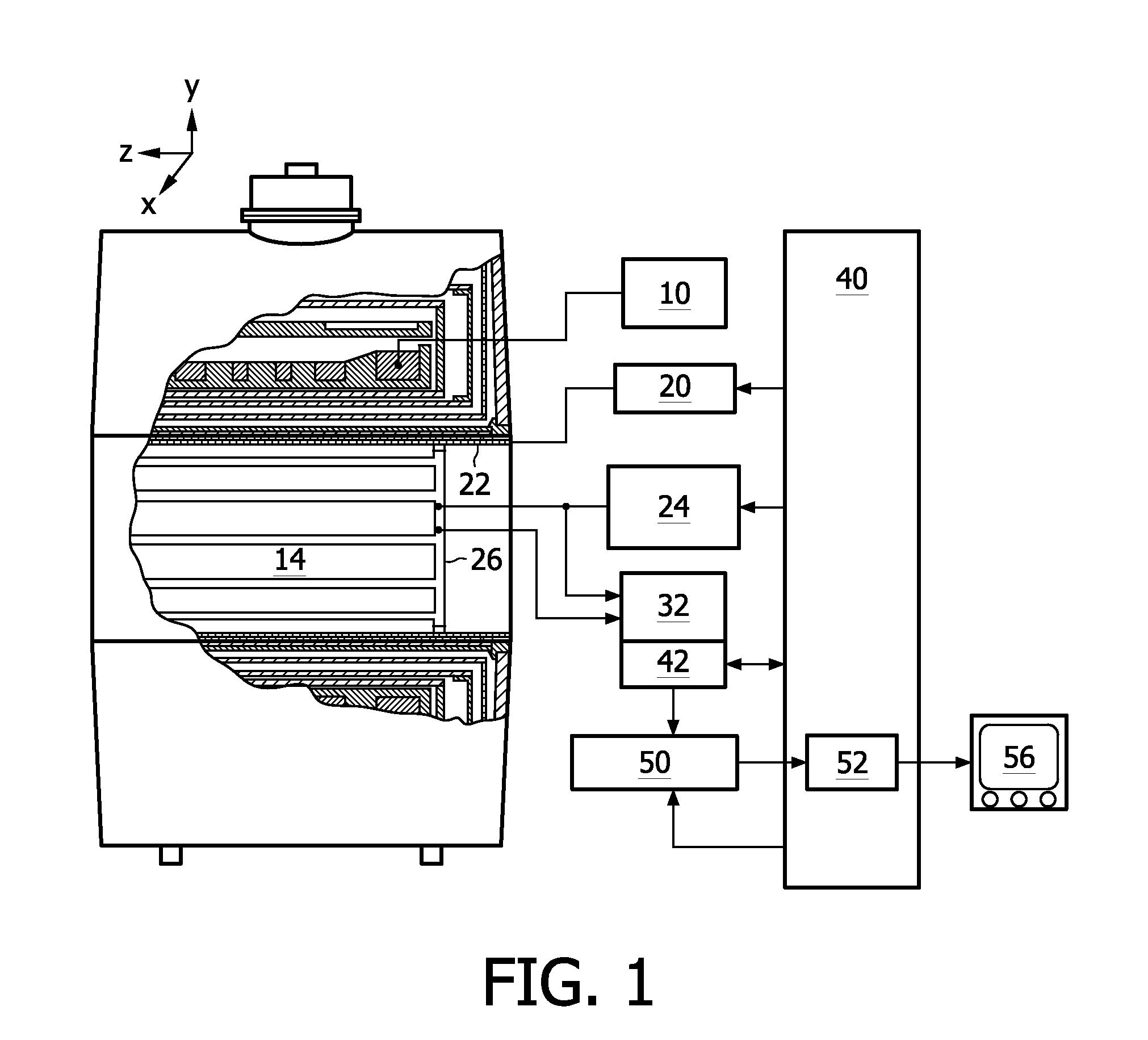[0014]After several cycles of steps a) to c) needed to build up saturation, a virtually full saturation (i.e. a ‘steady-state’ CEST effect) remains in each MR
signal acquisition step from the preceding acquisition cycle. An essential feature of the invention is that the duration of the saturation period is (much) shorter (at least by a factor of 5 or 10) than the time required to build up complete saturation when starting from zero saturation. Consequently, the time needed for saturation prior to each MR
signal acquisition step is very short according to the invention as compared to conventional CEST imaging approaches. The surprising effect of the invention is that an almost full-sized CEST
contrast enhancement effect can be obtained even though the duration of the saturation period is so much shorter than in conventional CEST approaches. This is due to the repetitive re-use of pre-existing saturation generated during previous cycles of steps a) to c).
[0015]As mentioned before, it turns out that after a certain number of repetitions of steps a) to c) of the method of the invention, a
steady state of saturation is achieved. In this
steady state a complete or nearly complete saturation (
plateau) can be made use of for CEST
contrast enhancement. It is an important aspect of the invention that the CEST technique may be applied in this steady state of saturation. A significant increase of imaging speed can be obtained because there is no need to wait for a re-build of the saturation prior to each MR signal acquisition step.
[0016]However, it is an import insight of the invention, that MR signal acquisition can start already during the saturation build-up period, i.e. before the steady state is achieved. It typically takes more than a second to approach a steady-state CEST condition. The
temporal resolution and speed of the technique of the invention can be significantly increased by using the initial CEST measurements for MR imaging and not (or not only) the steady-state CEST measurements. It is even possible within the scope of the invention to apply the technique in such a manner that the CEST contrast enhancement does not reach a
plateau value anymore. Only the initial part of the saturation build-up curve can be measured. With the approach of the invention, a
temporal resolution of 10 or more CEST measurements per minute is easily possible, at the expense of an insignificant decrease of the contrast-to-
noise ratio. In addition to the increased
time resolution and speed, the initial saturation build-up method of the invention has further advantages. For example, the steady-state CEST effect is known to be rather strongly dependent on T1. The initial build-up rate of the CEST contrast enhancement is less dependent on T1 as compared to the steady state CEST effect. For this reason, the initial build-up method of the invention is expected to perform better in tissues with short T1 relaxation times. Moreover, it turns out that the technique of the invention is advantageously less sensitive to direct saturation of
bulk water protons, which is one major issue in CEST imaging.
[0017]Especially the combination of the fast CEST MR imaging method of the present invention with existing techniques for rapid MR imaging (like FLASH, EPI and SENSE) constitutes a powerful tool for contrast-enhanced diagnostic MR imaging.
[0018]According to a preferred embodiment of the invention, the duration of the MR imaging sequence in step b) is selected such that saturation remains until
irradiation of the subsequent saturation RF pulse in step a). As explained above, if the duration of the saturation and signal acquisition steps are selected properly, saturation remains after each MR signal acquisition step such that the following saturation does not have to start form zero as in the conventional CEST approaches. Preferably, the duration of the MR imaging sequence in step b) is shorter than the duration of the saturation RF pulse in step a). An important aspect of the invention is that the exchangeable protons of the CEST contrast agent are essentially continuously saturated, wherein the generation and acquisition of MR signals for
image generation (steps b) and c)) take place during sufficiently short interruptions of the
irradiation of the frequency-selective saturation RF pulse. In a preferred embodiment of the method of the invention, the duration of the saturation RF pulse is 1-1000 milliseconds, preferably 2-200 milliseconds, while the duration of the MR imaging sequence is 1-100 milliseconds, preferably 1-50 milliseconds. In this way, a continuous series of CEST-enhanced
MR images can be acquired (for example for dynamic or modulated CEST imaging) with a
time resolution on the order of only 100 milliseconds or less.
[0019]It is advantageous to use RF pulses with small flip angles)(1-10° for the generation of MR signals in step b), in order to prevent direct saturation of the
bulk water MR signal while repeating steps a) to c). However, a small
flip angle is not essential for a successful application of the method of the invention. The CEST imaging approach of the invention may also be combined with ‘true FISP’ or ‘balanced FFE’ MR imaging methods. Such gradient-balanced MR imaging techniques effectively help to avoid unwanted direct saturation of the MR signal of water protons of the examined body.
 Login to view more
Login to view more  Login to view more
Login to view more 


